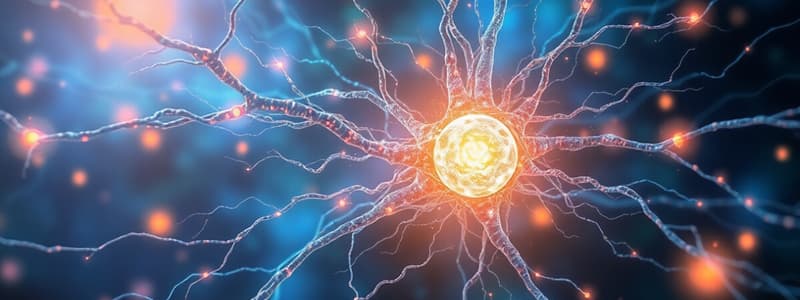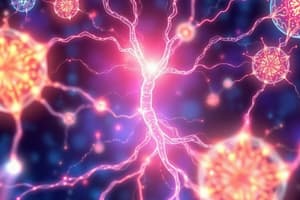Podcast
Questions and Answers
What is the primary function of sensory receptors within the sensory system?
What is the primary function of sensory receptors within the sensory system?
- To protect the body from external threats
- To regulate body temperature
- To enhance cognitive processing
- To transduce energy into neural signals (correct)
Which type of receptor is primarily located on the body surface and responds to external stimuli?
Which type of receptor is primarily located on the body surface and responds to external stimuli?
- Exteroceptors (correct)
- Proprioceptors
- Interoreceptors
- Mechanoreceptors
What do interoreceptors primarily detect?
What do interoreceptors primarily detect?
- Internal body stimuli (correct)
- Light and sound
- Chemical signals from the environment
- Touch and pain
Which of the following best describes the sensory unit?
Which of the following best describes the sensory unit?
What type of stimuli do Meissner’s corpuscles primarily respond to?
What type of stimuli do Meissner’s corpuscles primarily respond to?
Which type of sensory receptor is specialized for detecting temperature changes?
Which type of sensory receptor is specialized for detecting temperature changes?
What role do afferent nerves play in the sensory system?
What role do afferent nerves play in the sensory system?
What type of stimuli do mechanoreceptors primarily respond to?
What type of stimuli do mechanoreceptors primarily respond to?
What is the primary function of encapsulated nerve endings?
What is the primary function of encapsulated nerve endings?
Which of the following best defines an adequate stimulus?
Which of the following best defines an adequate stimulus?
Which characteristic makes each type of sensory receptor specialized?
Which characteristic makes each type of sensory receptor specialized?
How are sensory pathways related to the perception of stimuli?
How are sensory pathways related to the perception of stimuli?
Which of the following receptors is responsible for sensing skin stretch?
Which of the following receptors is responsible for sensing skin stretch?
What is the term for the process of converting energy forms into electrical signals in sensory systems?
What is the term for the process of converting energy forms into electrical signals in sensory systems?
Which sensory system aspect describes where a stimulus occurs?
Which sensory system aspect describes where a stimulus occurs?
Which type of receptor is responsible for detecting pain?
Which type of receptor is responsible for detecting pain?
How is the intensity of a stimulus primarily coded?
How is the intensity of a stimulus primarily coded?
What determines the acuity of a stimulus?
What determines the acuity of a stimulus?
Which statement about two-point discrimination is true?
Which statement about two-point discrimination is true?
What effect does lateral inhibition have on sensory acuity?
What effect does lateral inhibition have on sensory acuity?
Which type of receptor continues to send impulses as long as a stimulus is present?
Which type of receptor continues to send impulses as long as a stimulus is present?
Which statement correctly defines sensory adaptation?
Which statement correctly defines sensory adaptation?
Which characteristic is true of rapidly adapting (phasic) receptors?
Which characteristic is true of rapidly adapting (phasic) receptors?
What relationship exists between receptive field size and receptor density?
What relationship exists between receptive field size and receptor density?
Which pathway is responsible for the transmission of fine touch and vibration sensations?
Which pathway is responsible for the transmission of fine touch and vibration sensations?
What is the primary role of the first order neuron in the sensory pathway?
What is the primary role of the first order neuron in the sensory pathway?
Unilateral damage to the dorsal column pathway below the level of the medulla results in which sensation loss?
Unilateral damage to the dorsal column pathway below the level of the medulla results in which sensation loss?
Where is the primary somatosensory cortex (SI) located?
Where is the primary somatosensory cortex (SI) located?
What type of sensory information does the lateral spinothalamic tract transmit?
What type of sensory information does the lateral spinothalamic tract transmit?
Which of the following sensations is processed in the anterior spinothalamic tract?
Which of the following sensations is processed in the anterior spinothalamic tract?
What happens to sensation perception when there is contralateral damage above the medulla in the dorsal column pathway?
What happens to sensation perception when there is contralateral damage above the medulla in the dorsal column pathway?
What is true about the sensory pathways in the central nervous system?
What is true about the sensory pathways in the central nervous system?
Flashcards
Stimulus
Stimulus
The form of energy that activates a sensory receptor. Examples include heat, light, sound, and touch.
Sensory Receptor
Sensory Receptor
A specialized nerve cell that converts a stimulus into an electrical signal that the nervous system can understand.
Sensory Unit
Sensory Unit
A single afferent nerve fiber and all the sensory receptors connected to it, forming a functional unit for transmitting sensory information.
Exteroreceptors
Exteroreceptors
Signup and view all the flashcards
Interoreceptors
Interoreceptors
Signup and view all the flashcards
Sensory Homunculus
Sensory Homunculus
Signup and view all the flashcards
Somatic Sensory Pathways
Somatic Sensory Pathways
Signup and view all the flashcards
Perception of Intensity and Quality
Perception of Intensity and Quality
Signup and view all the flashcards
Thermoreceptor
Thermoreceptor
Signup and view all the flashcards
Nociceptor
Nociceptor
Signup and view all the flashcards
Mechanoreceptor
Mechanoreceptor
Signup and view all the flashcards
Chemoreceptor
Chemoreceptor
Signup and view all the flashcards
Baroreceptor
Baroreceptor
Signup and view all the flashcards
Proprioceptor
Proprioceptor
Signup and view all the flashcards
Sensory Transduction
Sensory Transduction
Signup and view all the flashcards
Sensory Coding
Sensory Coding
Signup and view all the flashcards
How is stimulus intensity encoded?
How is stimulus intensity encoded?
Signup and view all the flashcards
What is a receptive field?
What is a receptive field?
Signup and view all the flashcards
How is receptor density related to receptive field size?
How is receptor density related to receptive field size?
Signup and view all the flashcards
What is two-point discrimination?
What is two-point discrimination?
Signup and view all the flashcards
What is lateral inhibition?
What is lateral inhibition?
Signup and view all the flashcards
What is sensory adaptation?
What is sensory adaptation?
Signup and view all the flashcards
What are slowly adapting (tonic) receptors?
What are slowly adapting (tonic) receptors?
Signup and view all the flashcards
What are rapidly adapting (phasic) receptors?
What are rapidly adapting (phasic) receptors?
Signup and view all the flashcards
Dorsal Column Pathway
Dorsal Column Pathway
Signup and view all the flashcards
Spinothalamic Pathway
Spinothalamic Pathway
Signup and view all the flashcards
First-order Neuron
First-order Neuron
Signup and view all the flashcards
Second-order Neuron
Second-order Neuron
Signup and view all the flashcards
Third-order Neuron
Third-order Neuron
Signup and view all the flashcards
Somatosensory Cortex
Somatosensory Cortex
Signup and view all the flashcards
Primary Somatosensory Cortex (SI)
Primary Somatosensory Cortex (SI)
Signup and view all the flashcards
Secondary Somatosensory Cortex (SII)
Secondary Somatosensory Cortex (SII)
Signup and view all the flashcards
Study Notes
Sensory System Overview
- The sensory system is a complex network responsible for detecting and processing stimuli from the environment and the body.
- Sensory receptors are specialized nerve cells that transduce energy from stimuli into electrical signals.
- Different stimuli, including light, sound, touch, and temperature, are detected by specific types of receptors, each highly sensitive to one stimulus type.
- The sensory information travels along afferent nerves to the central nervous system (CNS), including the spinal cord and brain.
- The CNS then interprets these signals, leading to sensation and perception.
Sensory Receptor Classification
- Receptors are classified based on location, function, and structure:
- Location:
- Exteroceptors: respond to stimuli outside the body (Touch, pain, temperature, vision, hearing, smell, taste)
- Interoceptors: respond to stimuli within the body (internal organs, blood vessels, musculoskeletal system)
- Function:
- Nociceptors: respond to pain
- Thermoreceptors: respond to temperature changes
- Chemoreceptors: respond to changes in chemical concentrations (e.g., blood gases, dissolved substances)
- Mechanoreceptors: respond to physical distortions (e.g., touch, pressure, vibration, stretch)
- Structure:
- Free nerve endings: basic dendrites with little specialization.
- Encapsulated nerve endings: dendrites enclosed in a capsule of connective tissue.
- Specialized sense organs: specialized sensory cells for specific senses (vision, hearing, smell, taste, equilibrium)
- Location:
Sensory Transduction
- Sensory receptors transduce various energy forms (e.g., light, sound, heat, touch) into electrical signals.
- This process involves transforming stimulus energy into electrical signals (receptor potential). If it reaches threshold, an action potential occurs and travels to the CNS.
- Receptor potential is a graded potential similar to an excitatory postsynaptic potential (EPSP).
Sensory Coding
- The sensory system codes information about stimuli using patterns of neural activity.
- Key features encoded:
- Stimulus type (modality)
- Stimulus intensity (how strong)
- Stimulus location
- Stimulus duration
Sensory Pathways
- Sensory information travels through specific pathways to the CNS.
- Posterior/dorsal column (medial lemniscal) pathway: for fine touch, vibration, and proprioception.
- Spinothalamic pathway: for crude touch, pressure, pain, and temperature.
- Pathways consist of three neurons:
- First-order neuron: transmits signals from the receptor to the CNS.
- Second-order neuron: transmits signals to the thalamus.
- Third-order neuron: transmits signals from the thalamus to the somatosensory cortex.
Somatosensory Cortex
- Located in the postcentral gyrus of the parietal lobe.
- Processes sensory information for interpretation, localization, and perception.
- Receives input from the contralateral side of the body.
- Secondary somatosensory cortex (SII) plays a role in tactile object recognition and memory.
Sensory Homunculus
- A representation of the body in the somatosensory cortex.
- Areas with high sensitivity (e.g., hands, lips) have larger areas of representation.
- The size of the region reflects the sensitivity and not the overall size, of the body part.
Role of Sensory Receptors in Reflexes and Homeostasis
- Reflexes are automatic, subconscious responses to changes in the internal or external environment.
- Reflex arcs involve sensory receptors, sensory neurons, integration centers, and motor neurons.
- Sensory receptors are crucial for initiating and processing reflexes related to homeostasis (e.g., blood pressure regulation).
- Reflexes also enable fast responses to external stimuli to maintain posture and balance (e.g., stretch reflex).
Studying That Suits You
Use AI to generate personalized quizzes and flashcards to suit your learning preferences.




